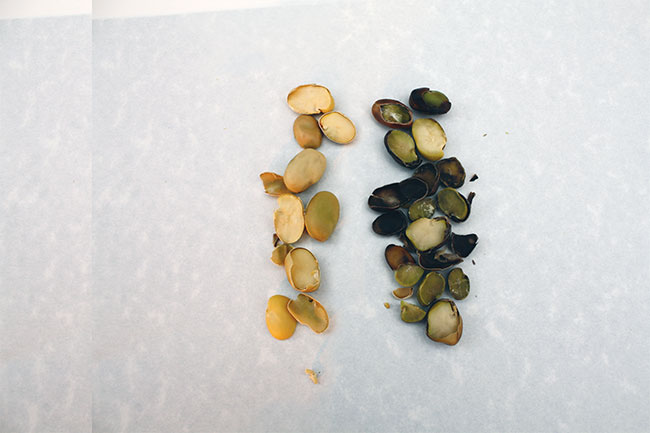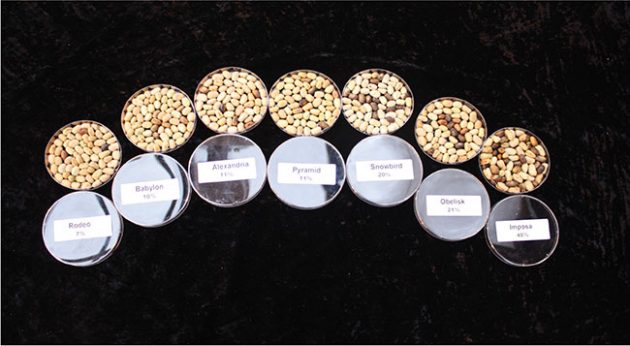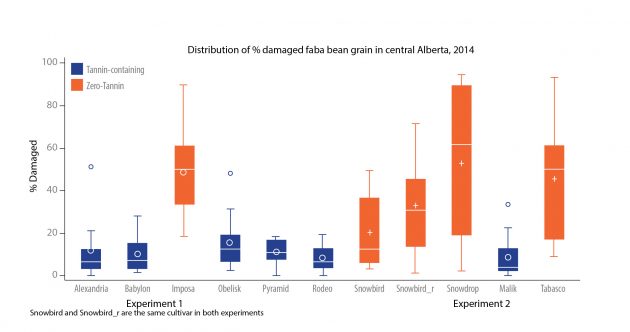
Features
Pulses
Agronomy
Genetics/Traits
Resisting fall frost damage
Tannin-containing fababean varieties less damaged by frost.
February 18, 2020 By Bruce Barker
 Undamaged (left) and frost damaged fababean.
Photos by Boris Henriquez.
Undamaged (left) and frost damaged fababean.
Photos by Boris Henriquez.
There’s something about tannins that help protect fababean seed from damage when Jack Frost comes calling. Boris Henriquez found that out when frost hit two Alberta Agriculture and Forestry (AAF) research experiments one September evening.
“At first we thought the differences in frost damage could have been because of differences in maturity. Maturity had a little bit to do with it, but it turned out that tannin-type varieties had way less damage than the zero-tannin varieties,” says Henriquez, a senior pulse crops technologist with AAF in Edmonton.
The two experiments were set up to evaluate the adaptability of non-registered European varieties in Alberta and the agronomic performance of newly registered varieties in Alberta. The frost event hit three sites in central Alberta, lasting 13 hours with temperatures dropping to -3 C in Morinville, -5.2 C in Barrhead and -6.5 C in Vegreville.
Noticing the differences in frost damage between the 10 varieties in the two experiments, Henriquez had his summer students put together a trial to assess the differences in frost damage between the varieties. They randomly collected 100-seed samples from the harvested grain for each variety, and assessed frost damage by visually determining the number of damaged seeds (blackened).
In Experiment 1, assessing European varieties, average frost damage ranged from 7.7 to 48.2 per cent. In Experiment 2, frost damage ranged from 8.6 to 54 per cent. However, the zero-tannin varieties had 2.2 times more frost-damaged seeds than normal tannin varieties in Experiment 1, and 4.5 times more in Experiment 2. These differences were found after accounting for differences in maturity.
For example, in Experiment 2, the zero-tannin variety Snowbird had 30.6 per cent frost-damaged seed while the tannin-containing variety Malik had 7.8 per cent frost-damaged seed. Tabasco, another zero-tannin variety, had 44.5 per cent frost-damaged seed.

Difference in frost damage of fababean varieties.
Distribution of frost damage in Experiment 1 and Experiment 2 in central Alberta
“I looked through the scientific literature and found a couple papers in Cryobiology [journal] that linked tannins to frost resistance, but the effects of tannins in preventing frost damage haven’t been studied very much,” Henriquez says.
Henriquez says the papers indicated that a possible mechanism explaining the role of tannins in frost protection is their activity as a supercooling promoting agent or anti-ice nucleating agent (anti-INA), which prevents intracellular ice formation and subsequent damage.
Although the frost event did cause damage to the seed, the average yield from frost-damaged varieties was similar to the other years in Experiment 1 when frost did not occur. Henriquez says the varieties were close enough to maturity that yield was not affected. Other research has found yields are not affected by frost when 30 per cent of the plants had the lowest pods turn black. However, he did observe that as the level of frost increased, the yield of affected varieties decreased, and this occurred more with the zero-tannin varieties.

Distribution of frost damage in Experiment 1 and Experiment 2 in central Alberta. Source: Henriquez et al. 2018
Henriquez says that further research on understanding how tannins help to reduce frost damage could assist plant breeders in selecting for this trait. If combined with earlier maturity, the selection for tannin-containing varieties that are more resistant to frost could reduce the risk of commercial downgrading. In the end, greater frost resistance could help improve marketability to the human and livestock markets.